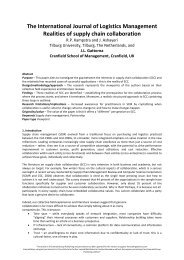customer segmentation based on buying and ... - John Gattorna
customer segmentation based on buying and ... - John Gattorna
customer segmentation based on buying and ... - John Gattorna
You also want an ePaper? Increase the reach of your titles
YUMPU automatically turns print PDFs into web optimized ePapers that Google loves.
differentiated approach. However, to create a deeper underst<strong>and</strong>ing of the requirements<br />
for each <str<strong>on</strong>g>customer</str<strong>on</strong>g> group, future <strong>and</strong> more qualitatively oriented research is needed.<br />
PRACTICAL IMPACT:<br />
The main purpose for differentiating service delivery levels is related to the problem of<br />
over <strong>and</strong> underservicing when using a “<strong>on</strong>e size fits all” approach (<strong>Gattorna</strong>, 2006). Our<br />
findings support <strong>and</strong> suggest the implementati<strong>on</strong> of service delivery <str<strong>on</strong>g>based</str<strong>on</strong>g> <strong>on</strong> a more<br />
dynamic approach that nurtures resources <strong>and</strong> links the supply chain <strong>and</strong>/or<br />
organisati<strong>on</strong>al strategies with categorized <str<strong>on</strong>g>customer</str<strong>on</strong>g> <strong>buying</strong> <strong>and</strong> returning behaviour.<br />
Keywords: Strategy, Customer Segmentati<strong>on</strong>, Differentiati<strong>on</strong>, E-Commerce, Buying<br />
Behaviour, Supply Chain Management<br />
Paper type: Research paper<br />
INTRODUCTION<br />
In shifting market c<strong>on</strong>diti<strong>on</strong>s, the choice of supply chain strategies is critical when<br />
competing to serve <str<strong>on</strong>g>customer</str<strong>on</strong>g>s (<strong>Gattorna</strong>, 2010). It is accepted in theory that the “<strong>on</strong>e size<br />
fits all” approach to supply chain design is no l<strong>on</strong>ger valid (Christopher et al., 2006;<br />
<strong>Gattorna</strong>, 2010; Ericss<strong>on</strong>, 2011; Godsell et al., 2011). Still organisati<strong>on</strong>s, even in the<br />
highly competitive e-commerce market, utilise a “<strong>on</strong>e size fits all” strategy to create <strong>and</strong><br />
deliver value to their c<strong>on</strong>sumers, thereby implicitly assuming that c<strong>on</strong>sumers' dem<strong>and</strong>s<br />
<strong>and</strong> <strong>buying</strong> behaviour are homogeneous, <strong>and</strong> therefore, there is no profitable reas<strong>on</strong> to<br />
differentiate delivery in terms of service.<br />
However, e-commerce c<strong>on</strong>sumers' <strong>buying</strong> behaviour is not homogenous, especially in the<br />
fast-moving c<strong>on</strong>sumer goods (FMCG) business. FMCG organisati<strong>on</strong>s compete not <strong>on</strong>ly in<br />
products <strong>and</strong> price, but also in a large variety of services. For example, accessibility <strong>and</strong><br />
speedy delivery are critical determinants for success. Returns management (RM) is clearly<br />
apartoftheparcel,<strong>and</strong>,ifh<strong>and</strong>ledproperly,itc<strong>and</strong>ecreasecosts,whilesimultaneously<br />
increasing revenue <strong>and</strong> serving as a means of competiti<strong>on</strong>. The total offer is called the<br />
“value package” <strong>and</strong> c<strong>on</strong>sists of the physical product plus the services surrounding it.<br />
Some of these services are the order qualifiers, <strong>and</strong> some are the order winners (Ericss<strong>on</strong>,<br />
2011).<br />
If <str<strong>on</strong>g>customer</str<strong>on</strong>g> groups exist with different service requirements, then it makes sense to try to<br />
match these with differentiated supply chain strategies (Godsell et al., 2011). <strong>Gattorna</strong><br />
(2010) argues that organisati<strong>on</strong>s, or rather supply chains, need not <strong>on</strong>ly to underst<strong>and</strong><br />
the competitive forces, they need also to underst<strong>and</strong> their <str<strong>on</strong>g>customer</str<strong>on</strong>g>s' <strong>buying</strong> behaviour.<br />
Furthermore, they need to underst<strong>and</strong> how to use the knowledge internally to offer <strong>and</strong><br />
deliver suitable value propositi<strong>on</strong>s. In e-commerce this has implicati<strong>on</strong>s <strong>on</strong> service<br />
delivery as well as the sourcing of products <strong>and</strong> thus <strong>on</strong> how we design the supply chains.<br />
In designing supply chains, Godsell et al. (2006) express a need to replace the focus from<br />
the product to the end-<str<strong>on</strong>g>customer</str<strong>on</strong>g> <strong>and</strong> specifically <strong>on</strong> the end-<str<strong>on</strong>g>customer</str<strong>on</strong>g>’s <strong>buying</strong> behaviour.<br />
Traditi<strong>on</strong>ally there are two different schools of thought in supply chain design (Godsell et<br />
al., 2011). Thefirsttheoryisthelean-agile supply chain design, which is product driven.<br />
The sec<strong>on</strong>d school of thought is that strategic alignment is driven by <str<strong>on</strong>g>customer</str<strong>on</strong>g> <strong>buying</strong><br />
behaviour. Both schools take a supply chain approach; thus, neither theory focuses <strong>on</strong> the<br />
c<strong>on</strong>sumer or the end-user as is d<strong>on</strong>e in this research.<br />
Supply chains are omnipresent (<strong>Gattorna</strong>, 2010), <strong>and</strong>e-commerce organisati<strong>on</strong>s exist in<br />
many supply chains or supply networks. As noted earlier, it is accepted that the “<strong>on</strong>e size<br />
fits all” approach to supply chain design is no l<strong>on</strong>ger valid, <strong>and</strong> the suggested number of<br />
parallel supply chains varies <strong>and</strong> is naturally c<strong>on</strong>text dependent. It depends up<strong>on</strong> diverse<br />
variables such as dem<strong>and</strong> uncertainties, product characteristics, replenishment lead-<br />
510







